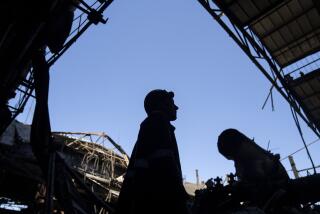Nuclear Plant Reopening to Cheers From Weary Armenians : Power: Most residents accept the risk after years of hardship because of electricity shortages.
- Share via
YEREVAN, Armenia — To Garina Khknavorian, the choice is clear: live with an aging Soviet-built nuclear power plant in her back yard, or spend another four years doing her family’s laundry by hand and by candlelight.
She’ll take the nuke any day, thank you.
“We understand that there is a risk, but to live endlessly under these conditions is impossible,” said Khknavorian, 47, an unemployed engineer. “We want to live like human beings.”
With a mixture of glee and anxiety, the citizens of electricity-starved Armenia watched last week as their government officially reopened a controversial nuclear power plant just 20 miles west of Yerevan, their earthquake-prone capital.
Armenia has spent about $42 million--much of it aid from Russia--retooling the reactor in Medzamor. Built in 1976, the nuclear plant has never had a reported accident, and it was not damaged by the devastating 1988 earthquake that killed about 25,000 people. Nevertheless, authorities shut it down in 1989 after thousands of demonstrators took to the streets to demand its closure.
Then came a punishing energy blockade imposed by Armenia’s neighbors because of the 7-year-old conflict with Azerbaijan over the enclave of Nagorno-Karabakh. Armenia’s factories ground to a halt. Yerevan’s subway service grew erratic. And through three bitter winters, electricity has been restricted to as little as an hour or two a day.
Desperate for warmth, Armenians felled an estimated 1 million trees for firewood, leaving the landscape bereft of shade during the baking Caucasian summers.
Families who could afford a $20 monthly bribe paid hospitals, bakeries or factories getting priority supplies of electricity for the right to string illegal power lines into their homes.
Other people bought jerry-built kerosene space heaters and slept in their clothes. Bread was rationed, and black-market gasoline prices soared. By some estimates, 700,000 of the 3.5 million Armenians fled the country.
Two years ago, despite opposition from the Group of Seven industrialized nations and from its neighbors--including Turkey, which is located just seven miles from Medzamor--Armenia decided to reopen the plant.
A visit to any ordinary Armenian home explains why the decision has met with almost no opposition.
The Khknavorians’ building is a 10-story slapdash stack of gray concrete blocks, the kind of ubiquitous structure that still blights the 11 post-Soviet time zones. Similar shoddy construction contributed to the collapse of scores of buildings during the 1988 Armenian earthquake and was also blamed for the high death toll in this spring’s powerful temblor on the Far Eastern island of Sakhalin.
In Soviet times, Yerevan had a higher standard of living than Moscow. But the years of war and deprivation have brought rapid decay. Inside the Khknavorians’ dilapidated building, the hall lights, elevator and water pump work only when there is electricity.
Even when the electricity comes on, it is rarely strong enough to pump water higher than the fifth floor, where the Khknavorians live. Their apartment receives running water for about five hours a day, but neighbors on the top floors come down to the Khknavorians to fill their buckets.
Despite the squalor in the corridor, the Khknavorians’ apartment is immaculate, with starched white lace covering each table. That alone is a triumph for Garina Khknavorian, whose days are consumed by the pre-industrial labor now required to care for her engineer husband, 20-year-old daughter and 14-year-old son.
The Khknavorians are relatively well-off by Armenian standards and have been able to afford a kerosene heater, gas canisters for cooking and an electric oven for baking.
Their son, David, an electronics whiz, has rigged an ingenious system of transformers and car batteries that allows the family to watch up to 10 hours of television when the power is off.
In summer, the refrigerator rarely gets enough power to cool, so Garina must shop every day or two. The family has a washing machine, but to use it, she must save up a bathtub of water and have it heating on the kerosene stove by the time the electricity comes on. It’s usually less trouble to wash by hand.
When the power finally comes on, Garina rushes to cook, vacuum, iron and wash, all in two hours. David spends the precious time playing with his personal computer.
“The other day--we hadn’t had any electricity at all for two weeks--and my mom just started to cry,” said daughter Anait. “She said she couldn’t stand it anymore. Dirty clothes were piling up in the bathroom, in the bedrooms. . . .”
“This has been going on for four years. . . ,” her mother said.
Fuel was loaded into the Medzamor plant on June 19, and the 400-megawatt plant had been producing small amounts of electricity for some time before last week’s official opening. If all goes well, officials promise that the plant will be working at full power by September, meeting 30% of the republic’s energy needs and giving consumers 12 hours of power each day.
A second, older reactor block at Medzamor is scheduled to open next year.
The Khknavorian family wants to believe government assurances that the plant is now mechanically and seismically safe. The West remains concerned that the plant lacks a containment dome to trap radiation in the event of an accident.
Nevertheless, Medzamor’s design is considered safer than that of the Chernobyl nuclear power plant, which spewed radiation over Europe after a catastrophic accident in 1986. Despite haunting fears of a repeat disaster, most Armenians think the plant must be reopened.
“Armenia is mountainous, and an earthquake is always a possibility,” said Anna Khachoyan, 65. “How safe the plant is, we just don’t know. But there will be power. And we need it. We are so tired already.”
More to Read
Sign up for Essential California
The most important California stories and recommendations in your inbox every morning.
You may occasionally receive promotional content from the Los Angeles Times.













